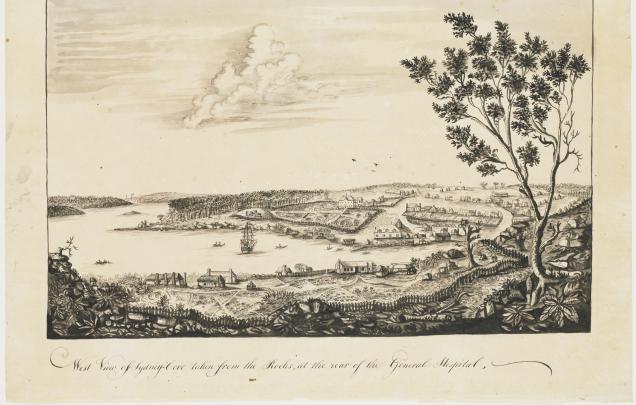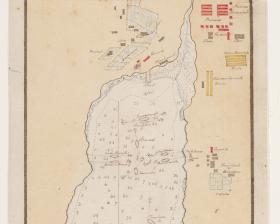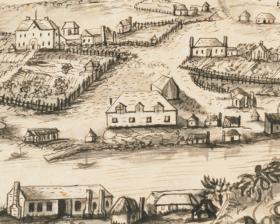Severe punishment
Students investigate harsh punishment for convicts who committed serious crimes.

Severe punishment
The colony was established by men who had been trained in the British Navy. They liked their ships to run like clockwork and everyone to do what they were told. Most of the convicts who had arrived with the First Fleet had not been sailors on a ship, and they did not always do what they were told. Some convicts continued to commit crimes after arrival in NSW. Some were hungry, cold or perhaps ill and others just continued their stealing practices from England. Governor Arthur Phillip was not happy about convicts reoffending or soldiers breaking the rules. He implemented harsh punishments for serious crimes. One was death by hanging.
Read the purpose that Lieutenant William Bradley gives for harsh punishment in May 1788:
strike these abandon'd wretches with Terror.
Answer these questions:
- Who are the abandon’d wretches?
- Why were the authorities wanting to strike terror?
- Do you think it worked? Would you feel terror?
Find the location of the first hanging in the colony on this map. It was from a tree between the men’s and women’s tents on the west side of Warrane/Sydney Cove. Look for the yellow rectangles on the right hand side of the image. Surgeon John White called it the “fatal tree”. This map was created by Lieutenant William Bradley and made on 1 March 1788, just over one month after they had arrived.

The first hanging involved a crime involving four convict men, including one named Thomas Barrett.
Read the diary entry of Lieutenant Ralph Clark on 27 February 1788 as he recorded the crime:
the charge being clearly Proven of their Stealing Butter Pease and Pork.
Three of them were sentenced to death and one was given the punishment of 300 lashes.
Answer these questions:
- Do you think the punishments matched the crime?
- Why was this punishment given for the crime of stealing food? [See Additional Information.]
Thomas Barrett was hanged on the same day as his sentence was handed down. Two of his accomplices, who had also been found guilty, were meant to be hanged the next day, but they were reprieved. The youngest accomplice was sentenced to be flogged but was also probably reprieved.
Read Surgeon White’s recollections of what further punishment was given to the two convict men instead of being hanged:
banished to some uninhabited place.
Answer this question:
- If this punishment of banishment to Pinchgut Island was carried out, how do you think these men might have survived? [Further information on Pinchgut Island can be found in Activity 8, The Trouble with Food, in the Food of the Colony learning activity.]
Read Marine Private James Scott’s list of those convicts executed by hanging in 1788:
Convicts Exacuted at Sidney Cove
1788 Feby 27th Thos Barren. Convict for Robing the publick Store [This is Thomas Barrett whose is mentioned above.]
May 2nd Jn Bennett, for Robing the Charlotte Transp Tent.
June 25th Jos Payton.for Breaking in to Capt Meradeths Marque With an Intent, to Rob the Same
Do. Ewd Corbet. For Stealing a Smock Frock from a Convict, & Absenting himself for 19 Days, in the Course of Which time he Was Out Lawd
Wednessday Dec 3rd 1788.—Dealey, Alise. The Goldfinder, For Stealing. Sundrey Articels from Convcits. & from. Lt Kellow & Mr Alt, Survayer
he Confessed to All at the Gallows.
Answer these questions:
- What is the same crime committed by all of these convicts?
- What does absenting himself for 19 days mean? Why is that a crime?
- Why do you think the death penalty was a deterrent to commit further crimes?
- Do you think we should have the death penalty today? Why?
In fact everyone in the colony was subject to equal punishment, not just the convicts. Governor Arthur Phillip, at the suggestion of a convict John Harris in 1789, agreed to the creation of early police constables called ‘watchmen’ who were all well-behaved convicts. The officer in charge of the marines, Major Robert Ross, suggested his soldiers should NOT be under the watch of this convict ‘police’ or ever be arrested. Governor Phillip did not agree.
Look at this image of one of the government storehouses in Sydney in 1789 in the centre of the drawing. This was the scene of a crime.

A group of seven soldiers stole food and alcohol from the government storehouses in the same year this drawing was created. They had sets of keys made and a system implemented. They would raid the storehouses when one of their group was on guard duty and two of the other men would be locked inside.
Read the continuation of this story by Judge David Collins in March 1789:
[They would] remain shut up until they had procured as much liquor or provisions as they could take off. If the patrols visited the store while they chanced to be within the walls, the door was found locked and secure, the sentinel alert and vigilant on his post, and the store apparently safe.
The group of soldiers continued this theft for eight months! They were caught when one of the seven soldiers tried to steal some supplies alone. Six of the seven soldiers were executed by hanging for the theft.
Answer these questions:
- Why were the soldiers stealing food? [See Additional Information.]
- If you were the Judge on this case, what punishment would you give?
- If you were in the soldiers’ situation would you commit that crime? Why?
- The soldiers were treated in the same way as the convicts. Is that fair? Why?
- How does that ‘same treatment of everyone’ from 1788 influence Australia today?
If the soldiers were motivated to risk punishment by stealing food, then the convicts were in the same situation but without the same access to the keys of the government stores. Convicts would also steal food from other peoples’ homes or gardens.
Other forms of punishment included flogging, head shaving, isolation and withdrawal of food rations. [For further information on flogging and head shaving see Activity 2, Why was Ann hurt?, of the Ann Martin: A Female Flogged learning activity. For further information on isolation and food as punishment see Activity 8, The Trouble with Food, of the Food of the Colony learning activity.]
Research the short but very creative and eventful life of First Fleet convict Thomas Barrett who was hanged for stealing food in February 1788, making him the first man hanged in the NSW colony.